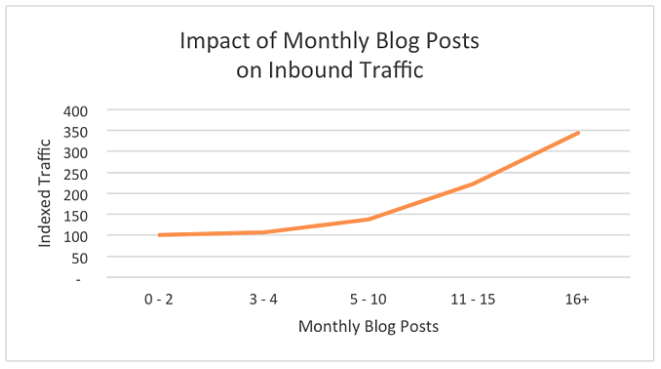Wie Sie Ihr Team zu Blogging-Profis machen
Wie oft sollte ein B2B-Unternehmen bloggen? Laut HubSpot haben "Unternehmen, die mehr als 16 Blogbeiträge pro Monat veröffentlichen, fast 3,5 Mal mehr Besucher als Unternehmen, die zwischen 0 und 4 Beiträge pro Monat veröffentlichen." Einmal pro Woche oder so zu veröffentlichen, ist für die meisten Unternehmen einfach nicht genug, um die Ergebnisse zu erzielen, die sie mit Corporate Blogging anstreben.
Andererseits mag es unerreichbar erscheinen, viermal pro Woche zu veröffentlichen. Die Einstellung eines dynamischen Content-Marketing-Teams ist ein guter Anfang. In der Tat beginnen die meisten unserer Kunden mit zweimal wöchentlichem Bloggen und arbeiten sich im Laufe der Zeit zu täglichen Beiträgen hoch.
Eine Möglichkeit, die Häufigkeit des Bloggens zu erhöhen, besteht darin, Mitarbeiter als Autoren oder Redakteure für die Aktualisierung bestehender Inhalte zu gewinnen. Schließlich sind sie bereits Fachexperten, und ihre Interaktionen mit den Kunden geben ihnen einen einzigartigen Einblick in wichtige Themen. Wenn Sie Ihre Mitarbeiter zu Publishing-Profis machen, ist das zwar mit etwas Arbeit verbunden, kann aber auch dazu beitragen, Ihrem B2B-Blog neue Tiefe zu verleihen. Das Wichtigste ist, dass Sie Ihre Mitarbeiter mit dieser Liste von "Do's" und "Don'ts" für das Corporate Blogging ausstatten.
Behalten Sie Ihr(e) Ziel(e) im Auge.
Wir neigen dazu, über das Bloggen aus einer SEO-Perspektive nachzudenken, aber das führt dazu, dass wir uns auf die Auswahl der richtigen Schlüsselwörter konzentrieren -schließlich schreiben wir all diese Inhalte, um von Suchmaschinen gefunden zu werden. Und das ist sicherlich eine wichtige Funktion des Bloggens. Denken Sie aber auch daran, dass das Bloggen drei weitere wichtige Vorteile hat:
-
Der Autor kann sich als Vordenker etablieren: Jeder Artikel, den ein Teammitglied verfasst, ist eine Gelegenheit, das fundierte Fachwissen oder die einzigartigen Einblicke des Teammitglieds als Experte für ein bestimmtes Thema zu präsentieren.
-
Positionierung des Unternehmens und seiner Produkte: Jeder Artikel ist eine Gelegenheit, das einzigartige Leistungsversprechen Ihres Unternehmens darzustellen.
-
Generieren Sie qualifizierte Leads für Marketing und Vertrieb: Das Ende eines Blogartikels ist der perfekte Ort für einen Call-to-Action (CTA), der die Leser auffordert, ihre E-Mail-Adressen mitzuteilen, um weitere Informationen zu erhalten (z. B. eine Fallstudie oder ein Whitepaper).
Mit jedem Blog-Artikel verfolgen wir also drei Ziele:
-
Erstellung informativer, relevanter und ansprechender Inhalte für Ihre Leser
-
SEO-freundliche Inhalte für Suchmaschinen erstellen
-
Professionelle Glaubwürdigkeit und Vertrauen aufbauen
Zu diesem Zweck helfen Ihnen die folgenden Empfehlungen, alle drei Ziele zu erreichen:
-
Beginnen Sie mit dem Ziel vor Augen: Dies mag wie eine eigennützige Empfehlung des Marketing-Teams klingen, aber denken Sie zuerst an Ihre CTA -was sollen Ihre Leser tun, wenn sie die Lektüre beendet haben? Planen Sie eine Demo. Laden Sie eine spezifische Fallstudie herunter. Achten Sie darauf, etwas zu wählen, das mit Ihrem Thema zusammenhängt.
-
Wählen Sie einen prägnanten Titel: Die ideale Titellänge beträgt 60 Zeichen, und Titel mit einer Länge von 8-14 Wörtern werden in den sozialen Medien am häufigsten aufgerufen. Twitter liegt am kürzeren Ende dieser Spanne, während Facebook und LinkedIn am längeren Ende der Spanne liegen. Listen sind im Allgemeinen gut (z. B.: 5 Gründe für...), funktionieren aber am besten im B2C-Bereich. Wir haben einen ganzen Artikel über Schlagzeilen geschrieben.
-
Sie können sich ruhig ein wenig langatmig machen: (Okay, nicht zu langatmig...) Studien zeigen, dass Google und andere Suchmaschinen zunehmend längere Inhalte bevorzugen -denken Sie an 1.500 bis 2.000 Wörter.
-
Denken Sie daran, wie Menschen online lesen: Online-Inhalte werden in der Regel schneller verarbeitet als gedruckte Inhalte. Es ist wichtig, dass Inhalte im Blog besser überfliegbar" sind. Das bedeutet, dass es für Blog-Autoren von Vorteil ist, kürzere Absätze, Zwischenüberschriften und Aufzählungen oder nummerierte Listen zu verwenden, wo dies angebracht ist.
-
Fügen Sie Bilder ein: Studien zeigen auch immer wieder, dass die Einbeziehung von Bildern das Engagement der Leser erhöht: Sie lesen eher weiter, klicken auf Links oder CTAs usw. Selbst die Verwendung von Archivbildern ist der Veröffentlichung eines nicht bebilderten Artikels vorzuziehen.
Sie suchen nach einem guten Modell? Sehen Sie sich diesen UberCloud-Beitrag über "Cloud-Technologien in der Pharmaindustrie". "Warum Softwareunternehmen ihre Kunden aufklären sollten" könnte ebenfalls hilfreich sein.
Zu vermeidende schlechte Blogging-Gewohnheiten
In der B2B-Welt sind einige der offensichtlichsten Blogging-"Don'ts" die Verwendung von Clickbait-Titeln, das zu frühe oder zu häufige Einfügen von Links und ein zu lockerer Ton. Andere, weniger offensichtliche schlechte Angewohnheiten sind die folgenden:
-
Annehmen, dass der Leser über das gleiche Wissen verfügt wie Sie: Wenn Sie mit Fachbegriffen und Konzepten um sich werfen, ohne sie richtig zu erklären, ist das ein absoluter Abtörner. Wenn Ihr Leser nicht versteht, wovon Sie sprechen, wird er aufhören zu lesen und zu jemandem weitergehen, der klarer und informativer ist.
-
Vernachlässigung der organisatorischen/visuellen Elemente des Artikels: Die meisten Menschen überfliegen Online-Artikel, und Textmerkmale wie Zwischenüberschriften, Aufzählungen und Bilder erleichtern das Überfliegen des Inhalts. Es kann hilfreich sein, eine grobe Gliederung Ihres Artikels zu erstellen, bevor Sie mit dem Schreiben beginnen. Dies ermutigt Sie, Ihr Thema in logische Abschnitte zu unterteilen, die als Zwischenüberschriften dienen können.
-
Sie haben den eigentlichen Zweck nicht im Blick: Letztendlich bloggen wir, um unseren Vertrieb und unser Marketing zu verbessern. Wenn Sie sich nicht sicher sind, wie Ihr Artikel zu den Marketingzielen passen könnte, erklären wir Ihnen das gerne und helfen Ihnen, einen "marketingfreundlichen" Blickwinkel für Ihren Artikel zu finden.
Weitere Tipps zum Wachstum durch Content Marketing finden Sie in unserem Leitfaden zur Erschließung von Unternehmenswachstum.
Dieser Beitrag ist auch verfügbar in:
- Englisch: How to Turn Your Team into Blogging Pros
- Spanisch: Cómo convertir a tu equipo en profesionales del blogging
- Französisch: Comment transformer votre équipe en pros du blogging
- Italienisch: Come trasformare il vostro team in professionisti del blogging
- Rumänisch: Cum să vă transformați echipa în profesioniști în blogging
- Chinesisch: 如何将团队打造成博客专家










Hinterlasse einen Kommentar